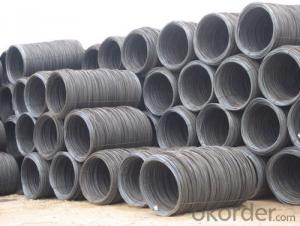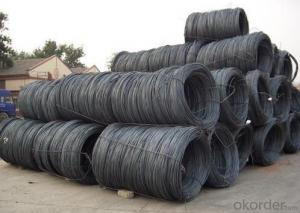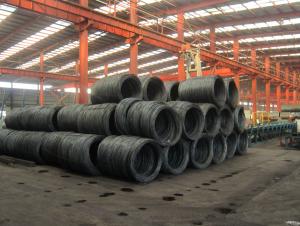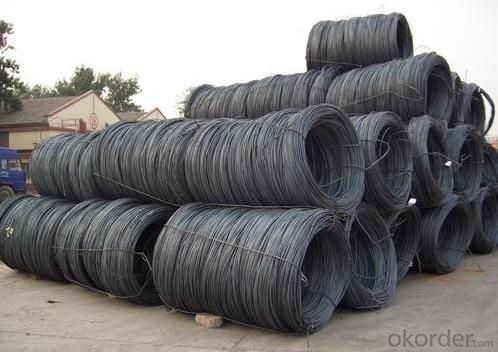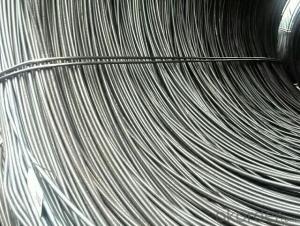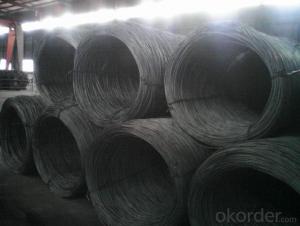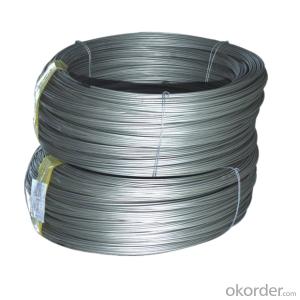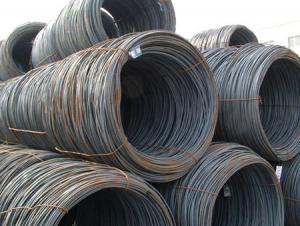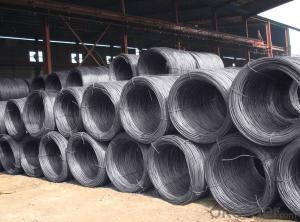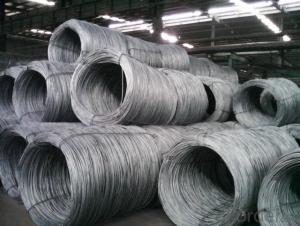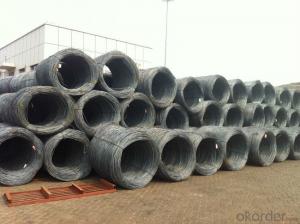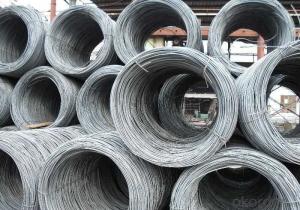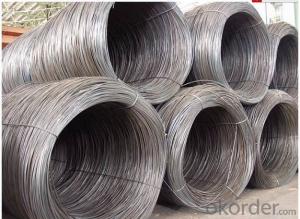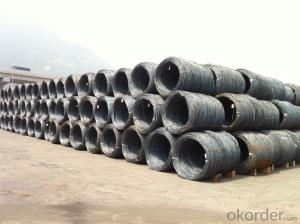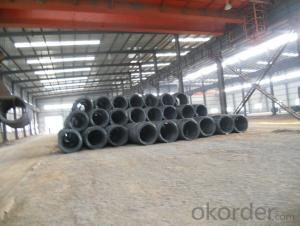High Quality Steel Wire Rod SAE1008 8.0mm
- Loading Port:
- Tianjin
- Payment Terms:
- TT or LC
- Min Order Qty:
- 50 m.t
- Supply Capability:
- 10000 m.t/month
OKorder Service Pledge
OKorder Financial Service
You Might Also Like
High Quality Steel Wire Rod SAE1008 8.0mm
Product Description:
Specifications of Wire Rod SAE1008:
Grade: SAE1008 Standard: ASTM
Diameter: 8.0mm
Alloy or Not: Alloy
Technique: Hot Rolled Place of Origin: China Mainland
Chemical Composition:
Please kindly find our chemistry of our material based on SAE1008 as below for your reference:
Grade | Chemical Composition (%) | |||||
C | Mn | S | P | Si | ||
SAE1008 | 0.10max | 0.32max | 0.045max | 0.040max | 0.30max | |
Mechanical properties | ||||||
Yield strength(N/mm2) | Tensile strength(N/mm2) | Elongation (%) | ||||
≥195 | 350-380 | ≥32 | ||||
Usage and Applications of High Quality Steel Wire Rod SAE1008 8.0mm:
After hot-rolled the products shaped into coil and delivery as finished product, including round, square,rectangular, hexagonal and so on. Since most of the products are round, it is generally called wire rod. Carbon steel wire rod is widely used in construction and manufacturing. Carbon steel wire rod is mainly used for reinforcement of reinforced concrete and welded structure or reprocessed (roberts , nail, etc.) materials, especially used to produce wire drawing, welding electrode, nails, spring, electronic, precise machinery parts and so on.
Packaging & Delivery of High Quality Steel Wire Rod SAE1008 8.0mm:
Packaging Detail: products are packed in coil and then shipped by container or bulk vessel
Each coil weight: About 2.05MT
Delivery Detail: within 45 days after received deposit or LC.
Label: to be specified by customer, generally, each bundle has 1-2 labels
Trade terms: FOB, CFR, CIF
FAQ:
Q1: Why buy Materials & Equipment from OKorder.com?
A1: All products offered byOKorder.com are carefully selected from China's most reliable manufacturing enterprises. Through its ISO certifications, OKorder.com adheres to the highest standards and a commitment to supply chain safety and customer satisfaction.
Q2: How do we guarantee the quality of our products?
A2: We have established an advanced quality management system which conducts strict quality tests at every step, from raw materials to the final product. At the same time, we provide extensive follow-up service assurances as required.
Q3: How soon can we receive the product after purchase?
A3: Within three days of placing an order, we will arrange production. The shipping date is dependent upon the quatity, how many sizes you want and the plan of production, but is typically 1 month to 2 month days from the beginning of production.
Images of High Quality Steel Wire Rod SAE1008 8.0mm:
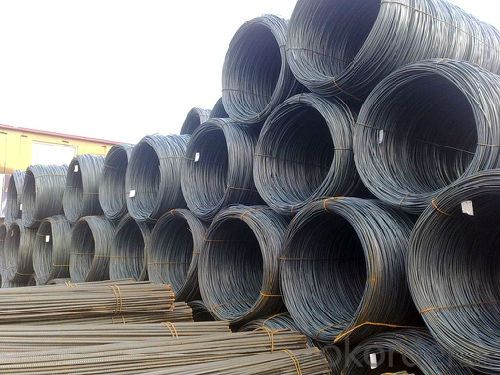
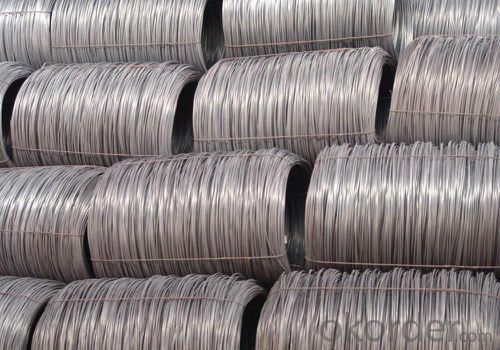
*If you would like to get our price, please inform us the size, standard/material and quantity. Thank you very much for your attention.
- Q: What are the main challenges in the steel wire rod industry?
- The operations and growth of the steel wire rod industry are impacted by several main challenges. To begin with, the volatility of raw material prices is one of the primary challenges. The industry heavily relies on inputs like iron ore and coal, and fluctuations in their prices can greatly affect profitability. This makes it challenging for companies to plan and forecast production costs. Additionally, intense competition is a struggle for the industry, both domestically and internationally. Many countries have a well-established steel wire rod industry, leading to oversupply and price wars. Manufacturers are under pressure to enhance production efficiency and reduce costs to stay competitive. Furthermore, environmental regulations and sustainability concerns pose another significant challenge. Steel wire rod production is energy-intensive and can result in emission of greenhouse gases and pollutants. Compliance with regulations and adoption of sustainable practices can add extra costs, requiring investments in new technologies and equipment. Moreover, meeting changing customer demands and preferences is a challenge for the industry. Customers now desire higher quality and customized steel wire rods that meet specific technical requirements. Manufacturers need to invest in research and development to develop new products and processes to meet these evolving needs. Additionally, the industry faces logistical challenges due to the heaviness and bulkiness of its products. Transportation costs can be high, especially for long-distance shipments, which impacts the competitiveness of manufacturers. Furthermore, the industry relies on a complex supply chain, and any disruptions or delays in the delivery of raw materials or finished products can have significant consequences for production schedules and customer satisfaction. Lastly, the steel wire rod industry is also vulnerable to economic cycles and global economic conditions. Slowdowns in construction and infrastructure projects, major consumers of steel wire rods, can lead to reduced demand and excess inventory. Economic downturns or trade disputes can also impact the industry's growth prospects and profitability. In conclusion, the steel wire rod industry faces various challenges, including volatile raw material prices, intense competition, environmental regulations, changing customer demands, logistical challenges, and economic fluctuations. Overcoming these challenges requires continuous innovation, improved efficiency, and adaptation to changing market conditions.
- Q: How is steel wire rod recycled in a steel production facility?
- Several steps are involved in the recycling process of steel wire rods to ensure efficient and sustainable reuse of this material in a steel production facility. Here is a breakdown of how the recycling process of steel wire rods takes place: 1. Collection and Sorting: Steel wire rods are collected from various sources, such as scrap yards, demolition sites, or manufacturing plants, and sorted based on their quality and composition. This sorting process allows for better control over the recycling process and ensures that only suitable materials are used. 2. Shredding and Fragmentation: Once sorted, the steel wire rods are shredded using heavy-duty machines, breaking them down into smaller pieces. This fragmentation increases the surface area of the material, making it easier to handle in subsequent steps. 3. Magnetic Separation: After shredding, powerful magnets are used to extract any ferrous materials, such as iron and steel, from the fragmented steel wire rods. This process effectively removes impurities and contaminants, leaving behind clean steel wire rods. 4. Melting and Purification: The clean steel wire rods are melted in a furnace at extremely high temperatures, turning the solid fragments into molten steel. Various additives and chemicals can be introduced during the melting process to refine the steel's composition and properties. 5. Casting and Solidification: The molten steel is then cast into molds to form new steel products or billets. These molds can be customized based on the desired shape and size of the final product. The molten steel is poured into the molds and left to cool and solidify. 6. Rolling and Drawing: After solidification, the steel billets go through rolling mills that progressively reduce their size and shape them into the desired final product, such as wire rods, bars, or sheets. If necessary, the steel may also undergo a drawing process, where it is pulled through a series of dies to achieve the desired diameter and shape. 7. Quality Control and Finishing: Before the final product is ready, it undergoes rigorous quality control inspections to ensure it meets the required specifications and standards. Any defects or imperfections are identified and corrected. Once approved, the steel wire rods are typically cleaned, coated, or treated to enhance their durability, corrosion resistance, or other desired properties. In summary, the recycling process of steel wire rods in a steel production facility involves collection, sorting, shredding, magnetic separation, melting, casting, rolling, quality control, and finishing. This comprehensive process effectively recycles steel wire rods, reducing the need for virgin materials and promoting sustainability within the steel industry.
- Q: How is surface quality assessed for steel wire rod?
- Surface quality for steel wire rod is assessed through visual inspection and various testing methods. This includes examining the wire rod for any surface defects such as cracks, pits, scratches, or irregularities. Additionally, non-destructive testing methods like ultrasonic testing and magnetic particle inspection are employed to detect any internal flaws or defects that may compromise the surface quality.
- Q: How is steel wire rod used in manufacturing?
- Steel wire rod is commonly used in manufacturing for various applications such as making wire mesh, reinforcing concrete structures, producing springs, cables, and wires for electrical purposes, and manufacturing various types of fasteners like bolts and screws. It is also utilized in the automotive industry to create components like suspension springs, tires, and seat belts. Overall, steel wire rod plays a crucial role in several industries due to its strength, durability, and versatility.
- Q: How is steel wire rod used in construction?
- Steel wire rod is commonly used in construction for various purposes. It is primarily used as a reinforcement material in concrete structures, such as beams, columns, and slabs, to enhance their strength and durability. Steel wire rod is also utilized to create welded mesh panels, which are used in the construction of walls, fences, and other structures. Additionally, it is employed in the production of pre-stressed concrete, which is used in the construction of bridges and other large-scale infrastructure projects.
- Q: How is the microstructure of steel wire rod analyzed?
- The microstructure of steel wire rod is analyzed using various techniques and methods to understand its properties and quality. One common method is metallography, which involves preparing a sample of the steel wire rod by cutting and polishing it to create a flat and smooth surface. The prepared sample is then etched with a chemical solution to reveal the microstructure under a microscope. Optical microscopy is often used to analyze the microstructure of steel wire rod. It allows for the observation of various features such as grain size, grain boundaries, and the presence of any impurities or defects. This technique provides valuable information about the quality and performance of the steel wire rod. Another widely used technique is scanning electron microscopy (SEM). SEM provides a higher magnification and resolution compared to optical microscopy, allowing for more detailed analysis of the microstructure. It can reveal the surface morphology, grain boundaries, and the presence of any precipitates or phases in the steel wire rod. Transmission electron microscopy (TEM) is a more advanced technique used for analyzing the microstructure of steel wire rod. It involves preparing an extremely thin sample, typically less than 100 nanometers thick, which is then examined using an electron beam. TEM provides even higher resolution and can reveal the atomic structure, dislocations, and other fine details of the microstructure. In addition to microscopy techniques, other methods such as X-ray diffraction (XRD) and electron backscatter diffraction (EBSD) can also be used to analyze the microstructure of steel wire rod. XRD helps in identifying the crystallographic phases present in the steel wire rod, while EBSD provides information about the crystal orientations and texture. Overall, the analysis of the microstructure of steel wire rod is crucial for understanding its mechanical properties, durability, and potential applications. These various techniques and methods enable researchers and manufacturers to assess the quality and ensure the desired microstructure for specific purposes.
- Q: What are the main factors affecting the market policies of steel wire rod?
- The main factors affecting the market policies of steel wire rod are supply and demand dynamics, global economic conditions, trade policies and regulations, technological advancements, and competition within the industry. Additionally, factors such as raw material costs, energy prices, environmental regulations, and government policies related to infrastructure development and industrial growth also play a significant role in shaping the market policies for steel wire rod.
- Q: What are the main factors affecting the market investments of steel wire rod?
- Some of the main factors affecting the market investments of steel wire rod include supply and demand dynamics, global economic conditions, government policies and regulations, technological advancements, competition from alternative materials, and fluctuations in raw material prices. Additionally, factors such as infrastructure development, construction and manufacturing activities, and the overall health of industries that use steel wire rod also play a significant role in influencing market investments.
- Q: What are the common production processes for silver-coated steel wire rod?
- The common production processes for silver-coated steel wire rod typically involve wire drawing, cleaning, coating, drying, and coiling.
- Q: How is steel wire rod used in the manufacturing of clothes hangers?
- Steel wire rod is used in the manufacturing of clothes hangers as it provides the necessary strength and durability required to hold and support garments without bending or breaking. The wire rod is formed into the desired shape and size, allowing it to be easily molded into the traditional hanger design. Additionally, the smooth surface of the steel wire rod prevents any damage or snagging to the clothes, ensuring they remain in good condition.
Send your message to us
High Quality Steel Wire Rod SAE1008 8.0mm
- Loading Port:
- Tianjin
- Payment Terms:
- TT or LC
- Min Order Qty:
- 50 m.t
- Supply Capability:
- 10000 m.t/month
OKorder Service Pledge
OKorder Financial Service
Similar products
Hot products
Hot Searches
Related keywords
